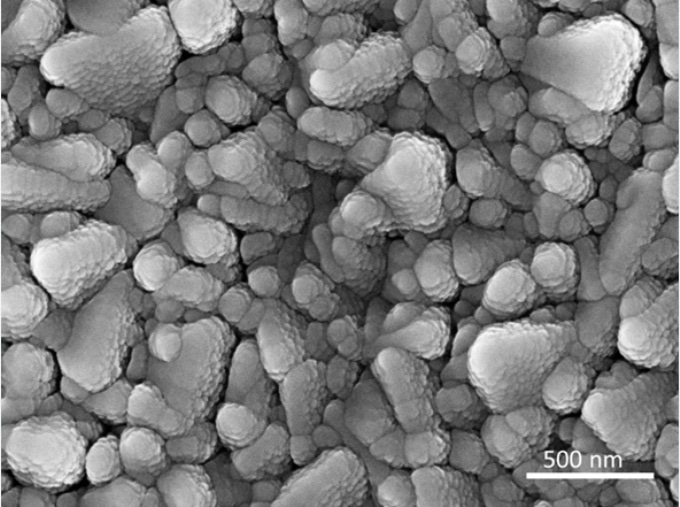Apr 5 2019
The production of hydrogen from sunlight will need efficient and cost-effective catalysts. Molybdenum sulfides are regarded as good candidates.
 The SEM shows molybdenum sulfide deposited at room temperature. (Image credit: HZB)
The SEM shows molybdenum sulfide deposited at room temperature. (Image credit: HZB)
A group of researchers at HZB has now described what processes occur in molybdenum sulfides during catalysis and why amorphous molybdenum sulfide works best. The outcomes of the study have been reported in the journal ACS Catalysis.
In addition to generating electricity, sunlight can be used to produce hydrogen. Hydrogen is a climate-neutral fuel that stores energy chemically and releases it again when required, as electrical energy in a fuel cell or directly through combustion—the byproduct of which is only water. However, to obtain hydrogen from sunlight, catalysts that speed up the electrolytic splitting of water into hydrogen and oxygen are required.
Molybdenum Sulfide Layers Explored
Molybdenum sulfides (MoSx) are a specifically interesting family of catalysis materials for hydrogen generation. They are significantly cheaper than catalysts composed of ruthenium or platinum. In a detailed study, a group headed by Prof. Dr Sebastian Fiechter at the HZB Institute for Solar Fuels has currently synthesized and studied a range of molybdenum sulfide layers.
The samples were deposited on a substrate at various temperatures ranging from room temperature to 500 °C. The structure and morphology of the layers vary with increasing deposition temperature. At higher temperatures, crystalline regions are developed; however, molybdenum sulfide deposited at room temperature is amorphous. It is exactly this amorphous molybdenum sulfide deposited at room temperature that has the maximum catalytic activity.
Amorphous MoSx Layers Emit H2S Initially
A catalyst composed of amorphous molybdenum sulfide releases hydrogen during electrolysis of water as well as hydrogen sulfide gas in the starting phase. The sulfur for this had to be derived from the catalyst material itself, and surprisingly, this process significantly enhances the catalytic activity of the molybdenum sulfide. Presently, Fiechter and his group have closely looked at this and are offering an explanation for their findings.
Spectroscopic Methods Show What Happens
They examined amorphous molybdenum sulfide samples used as catalysts in water splitting with the help of different spectroscopic techniques, including in situ Raman spectroscopy. These measurements indicate that nanocrystalline regions of molybdenum disulfide (MoS2) eventually develop in amorphous molybdenum sulfide samples due to sulfur escaping from molybdenum clusters. Simultaneously, smaller amount of hydrogen sulfide is formed, so that hydrogen production becomes paramount.
Islands of Nanocrystalline MoS2
We can deduce from the data that low-sulfur areas with islands of nanocrystalline MoS2 form as a result of the sulfur escaping. The islands act as catalytically active particles.
Fanxing Xi, HZB Institute for Solar Fuels.
Xi performed these measurements as part of her doctoral work.
These insights can contribute to further improving the catalytic activity and stability of this promising catalyst for hydrogen generation in the water-splitting process, and coupling the material to an electrolyzer operating solely on sunlight.
Prof. Dr Sebastian Fiechter, HZB Institute for Solar Fuels.